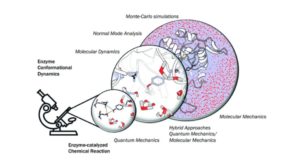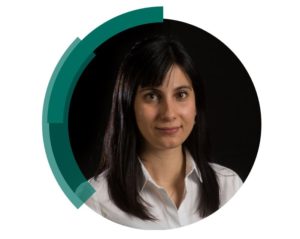We’re celebrating researchers who published their first independent article with ChemComm. Professor Sílvia Osuna published her first article in 2017: Computational tools for the evaluation of laboratory-engineered biocatalysts. We wanted to find out more about Sílvia and her research – Read more below.
 What are the main areas of research in your lab and how has your research progressed since publishing your first article?
What are the main areas of research in your lab and how has your research progressed since publishing your first article?
The main research areas in my lab are the application and development of computational tools for evaluating laboratory-engineered enzymes, with the final goal of rationally designing new enzymes. The Feature article published in Chem. Commun. in 2017 focused on providing an overview of the available computational strategies that can be used to evaluate laboratory-engineered enzymes. Since then, we have computationally evaluated a variety of enzymes mostly through extensive Molecular Dynamics simulations (monoamine oxidase, tryptophan synthase, and alcohol dehydrogenases, among others) to unveil the role exerted by distal active site mutations on the enzyme conformational landscape. Most importantly, we have also developed new computational tools for predicting active site and distal mutations for enhanced activity (Shortest Path Map tool), which we are currently applying for altering the conformational dynamics of different enzymes. The key role exerted by remote mutations on the active sites of enzymes suggests that allostery (i.e. regulation of enzyme function by distal positions) might be an intrinsic characteristic of enzymes, which we are exploiting for enzyme evolution. Therefore, our research is now more focused on applying the developed tools to rationally design new enzyme variants rather than evaluating and explaining the enhanced activities of previously reported laboratory-engineered enzymes.
What do you hope your lab can achieve in the coming year?
I hope in the coming year we can further validate our computational tools for predicting distal active site mutations. Due to the broad sequence space of enzymes, the computational prediction of such distal mutations has been proven to be extremely challenging. However, our new tools developed open the door to new protocols based on the introduction of active site and also distal mutations. This is totally unprecedented in the computational enzyme design field, and I hope in the coming year we can further demonstrate that our developed computational tools can be successfully applied for enzyme design.
Describe your journey to becoming an independent researcher.
I received a PhD in 2010 from the University of Girona (UdG) at the Institut de Química Computacional (IQC) under the supervision of Prof. Miquel Solà and Prof. Marcel Swart. I worked on the computational study of the chemical reactivity of carbon-based compounds, such as (metallo)fullerenes and carbon nanotubes. In October 2010 I moved to the group of Prof. Houk at the University of California, Los Angeles (UCLA) thanks to the IOF Marie Curie fellowship. At that time, I started to work in the computational design of enzymes of medical and pharmaceutical interest. In December 2013, I rejoined the Institute of Computational Chemistry and Catalysis (IQCC) at the University of Girona with a postdoctoral Juan de la Cierva position. I was also awarded a Career Integration Grant (CIG) project for developing a computational protocol for designing new enzymes, and also an I+D MINECO Project together with Prof. Swart. In 2015, I obtained a European Research Council – Starting grant project (ERC-StG) to apply network models for the computational design of efficient enzymes (NetMoDEzyme), and also a 5-year Ramón y Cajal position from the Spanish government. In 2018, I was promoted to the current permanent ICREA position I currently hold. My group is now funded by the ERC-StG project, an I+D MINECO project, and a Human Frontier Science Program project.
What is the best piece of advice you have ever been given?
My grandmother used to tell me a Catalan saying “De pressa i bé, mai s’avingué”, which I believe the English equivalent would be “Slow and steady wins the race”. There are of course exceptions to the saying, but I believe it is a generally good advice that also applies in scientific contexts.
Why did you choose to publish your first article in ChemComm?
I received an invitation to submit a Feature article to ChemComm a few months after being awarded the ERC-StG project. I decided this was an excellent idea as I had already done an extensive bibliographic search for writing the ERC project. Most importantly, I like ChemComm, its published Feature articles, and its broad readership. I was also really happy to see that our published Feature article was included in the most downloaded articles of 2017 in physical and environmental chemistry. When I received a second invitation to contribute with a second Feature article in 2018, I didn’t hesitate to accept the invitation.
Sílvia received her PhD in 2010 from the University of Girona (UdG) at the Institut de Química Computacional (IQC) under the supervision of Prof. Miquel Solà and Prof. Marcel Swart. In 2010, she moved to the group of Prof. Houk at the University of California, Los Angeles (UCLA). In 2012, she rejoined the Institute of Computational Chemistry and Catalysis (IQCC) at the University of Girona with a postdoctoral Juan de la Cierva position, which was followed by a Ramon y Cajal contract, and her current permanent ICREA research professor position. Sílvia’s research lies at the interface between computational chemistry and biology. Her research focuses on the study of biochemical processes mainly related to enzyme catalysis.
Read more from our ChemComm1st authors in ChemComm Milestones – First Independent Authors











